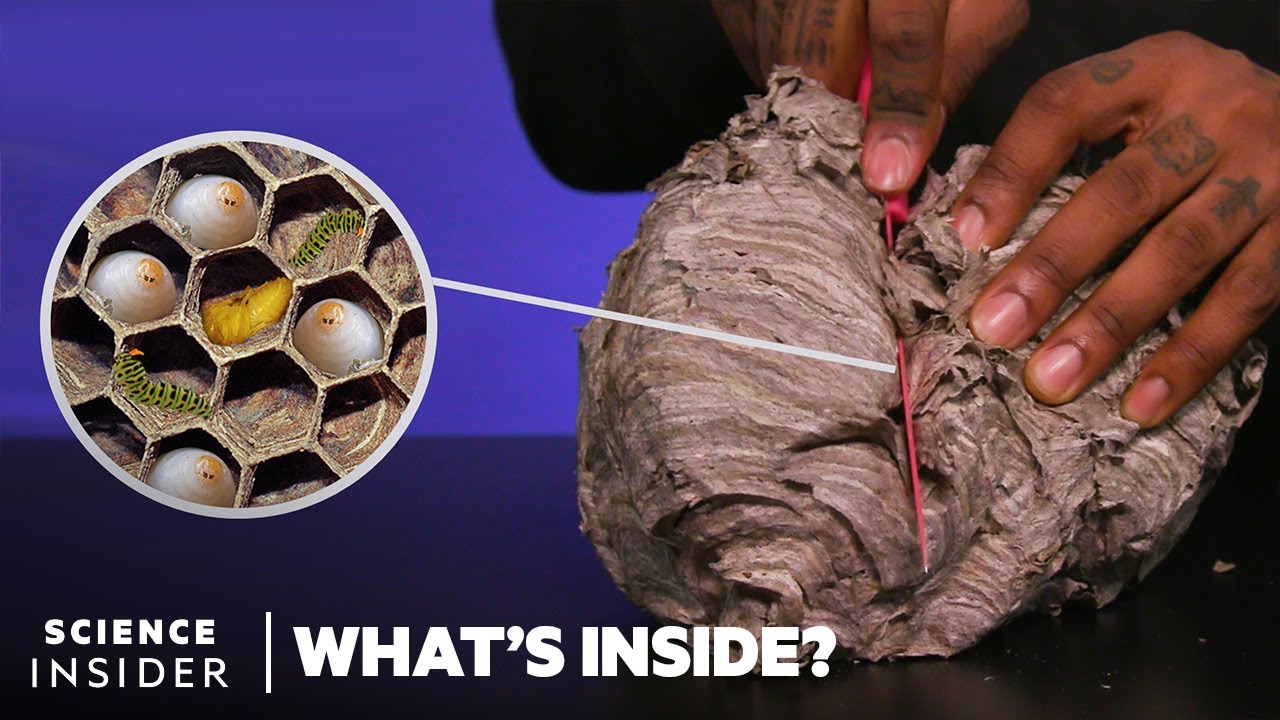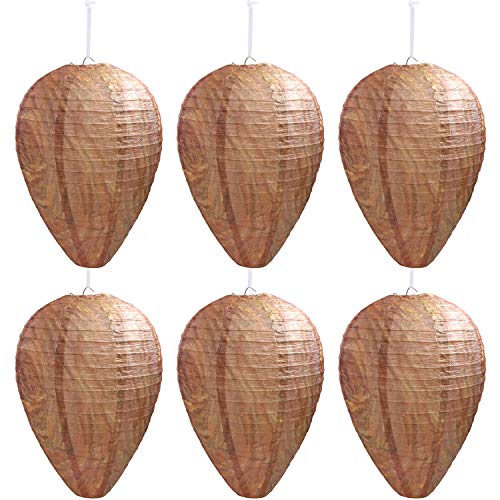Inside A Wasp Nest
This is a wasp nest. In the wild, some of these nests are built underground using clay or mud. But you might be most familiar with the paper nests — the ones built out of saliva and pulp, typically found attached to buildings or trees. And these guys can get big. According to the Guinness Book of World Records, the largest wasp nest was 12 feet long and 18 feet all around. Now, we’re all accustomed to avoiding these nests, because, obviously, wasps are scary, but today we’re going to go inside one, because there are a lot of fascinating factors that make these nests work for wasps and their babies. So, let’s cut into one. Pretty easy to cut through this. The hardest part was definitely here at the top, where you can tell the cells are more dense and wider. If I can give you a scale for how big this is, I mean, like, look at it next to my head. This is like a brick cellphone from the ’90s. The key to this type of nest is the pedicel, or the root. It’s the foundation that the entire nest is built off of. These are the cells. Wasps are like butterflies. They’re what’s called holometabolous insects, meaning they go through a metamorphosis before they become adults, and these cells are basically their cribs.
Petrovicheva: The cells are open when they first are produced. The queen will lay their egg in there, and then it’ll get sealed off.
Mills: They’re shaped similar to a hollow cylinder, or like a regular lead school pencil, and there’s a reason why.
Petrovicheva: The walls of the hexagon hold the other cells. Also, they’re a compact space, so you can get a lot of these cells in very, very small space while still having a very strong structure.
Mills: They’re also perfectly sized to fit both the larva and its roommates.
Petrovicheva: Oftentimes there’s some food laid in with the egg, so when it hatches it has the food in there already. The drones move from cell to cell in a circular motion, making sure that each larva has food. Some wasp species tear up insects for the babies, but other wasps take things further. Mason wasps drop off whole caterpillars for their children to eat alive, while tarantula hawk wasps lay their eggs on tarantulas they sting and paralyze as a birthday feast. Other species lay their eggs inside their prey, and once the larvae hatch, they have a meal waiting for them to chew their way out of.
Petrovicheva: Once the larva is ready to metamorphose, it’ll become a pupa inside the cell still, and then it’ll hatch as an adult.
Mills: Since the cells are both the crib and the cocoon for these wasp babies, the nest must maintain a stable temperature with high humidity. This means as much insulation as possible. For these types of nests, the domes are almost always made of salivary secretions, plant material, or paper or cardboard.
Petrovicheva: So, they take wood, they chew it up, and they mix it with saliva to make a glue, and then they lay it in thin layers. The denser the layers, the stronger and more sturdy the structure. After building the core structure, the queen wraps the entire nest in an envelope — these thin sheets of macerated pulp.
Mills: This layer basically protects the comb, or each layer of cells, limiting the entrance to one tiny little hole. Scientists think this helps to maintain the internal temperature and humidity of the structure. And more cones can be added on with more pedicels, sort of like expanding a mansion with tiny little staircases that the wasps can use to get from one area to another. So, now I know the question on some of your minds is, “Is there honey in a wasp nest?” And the answer is no. While both bees and wasps pollinate flowers, bees actually farm nectar to turn it into honey, the food source for their larvae. Most wasps, on the other hand, are meat eaters and prefer a diet of freshly chewed insects, meaning you won’t find honey in their nests, but you might find a lot of dead bugs. So, the next time you see one of these nests and you’re tempted to knock it down, maybe back off. Those wasps put a lot of effort into building this crib for their babies. We don’t want to tick them off.
Inside A Wasp Nest
Inside a wasp nest is a world of constant, frenzied activity. The walls are covered in a thick, dark substance that is the product of thousands of insects all working together to create a home. As they work, they constantly fight each other for space and dominance. The queen rules over this chaos, laying eggs and controlling the workers who construct her empire.
The texture of the inside of the nest is rough and sticky, like an old tennis ball or a piece of bubble gum that’s been stepped on by hundreds of people.
List Of Inside A Wasp Nest
- This 10″ wide x 14″ height, realistic looking, hornet’s nest decoy is a proven outdoor wasp repellent that will last for years.
Additional Info :
| Color | Gray |
| Item Dimensions | |
| Height | 1 Inches |
| Width | 8.5 Inches |
| Length | 7 Inches |
Additional Info :
| Item Dimensions | |
| Height | 9.5 Inches |
| Width | 0.44 Inches |
| Length | 8.5 Inches |
| Weight | 0.7 Pounds |
DECYOOL 2 Pack Wasp Nest Decoy Wasp Deterrent for Hornets Yellow Jackets Outdoor Waterproof Material
- Design Principle: Wasp nest decoy could deterrent wasps by simulating the look of an enemy hive in size, shape, and color, several species of wasps and hornets will not build nest near another colony.
- Waterproof material: Made with super light polyester to repel rain and resist wind, way more durable and resilient than paper fake wasp nest. Built for outdoor use in tough environments.
- Safe: Just simply hang the fake wasp nest.
- Size: 2 Pack of durable artificial wasp nests, each hanging eco-friendly wasp deterrent measures 8.5 inches in diameter with a height of 11 inches.
- Easy to hang: You can hang the wasp nest anywhere you want clear of wasps.If you received the item came without the inner wires to make it expand.please contact us in time.
Additional Info :
| Color | Dark color |
| Item Dimensions | |
| Height | 0.5905511805 Inches |
| Width | 8.661417314 Inches |
| Length | 11.023622036 Inches |
- Package: 6 fake wasp nests per package are enough for you to use.
- Size: once propped open, the hanging deterrence nest is about 8 x 11 inches in size.
- Stay away from wasps: several species of wasps and hornets will not build nest near another colony.
- Safe: Just simply hang the fake wasp nest.
- Easy to Deploy – Only a few steps to assemble the wasp nest decoy, and then you can hang it on eaves, decks, dense tree canopy or any other outdoor area protected from rain. Please do not place it in a humid area to avoid product damage.
Additional Info :
| Color | A-yellow |
| Item Dimensions | |
| Height | 0.9842519675 Inches |
| Width | 8.8976377862 Inches |
| Length | 11.2204724295 Inches |







